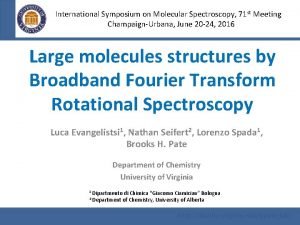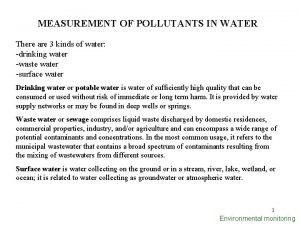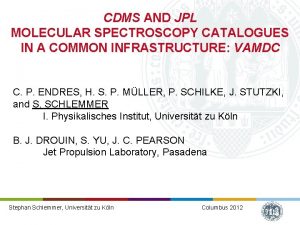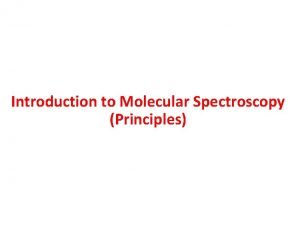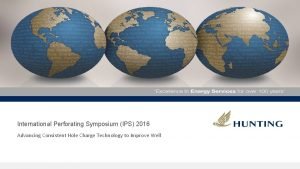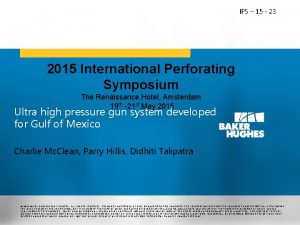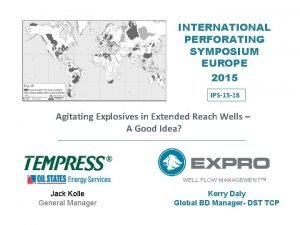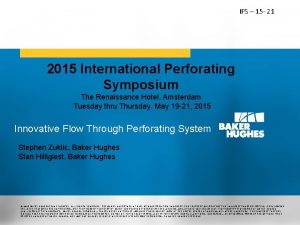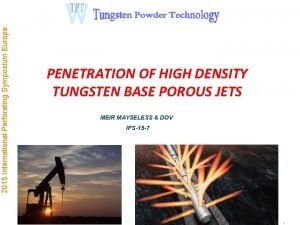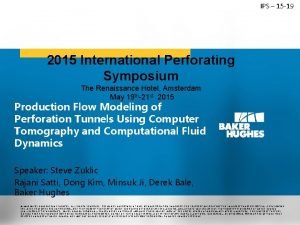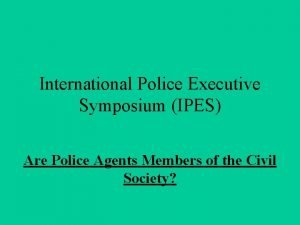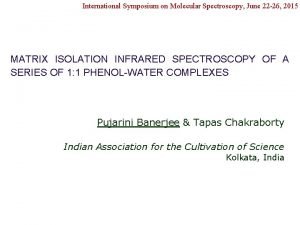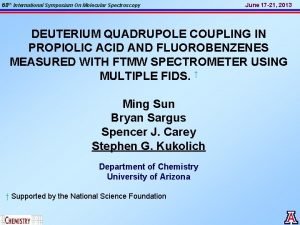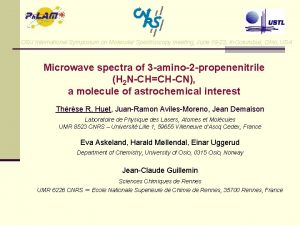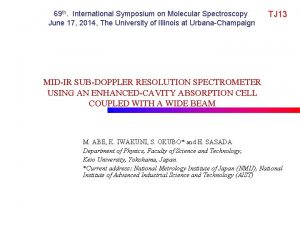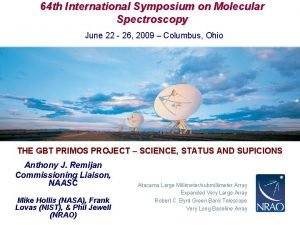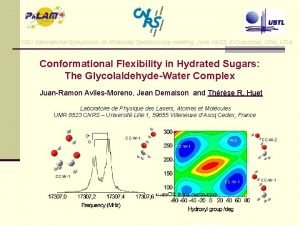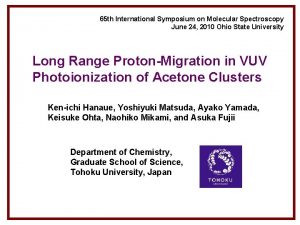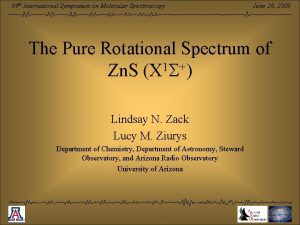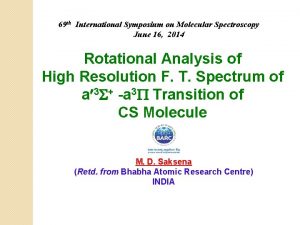72 nd International Symposium on Molecular Spectroscopy June












- Slides: 12

72 nd International Symposium on Molecular Spectroscopy June 19 -23, 2017 - Champaign-Urbana, Illinois THE OHIO STATE UNIVERSITY Non-Equilibrium Thermodynamics Laboratory ELECTRIC FIELD MEASUREMENTS IN NS PULSE DISCHARGES BY 4 -WAVE MIXING Marien Simeni, Edmond Baratte*, Kraig Frederickson, and Igor V. Adamovich Department of Mechanical & Aerospace Engineering The Ohio State University *Ecole Centrale Paris

Motivation and Objectives • Time-resolved electric field in ns pulse discharges controls electron energy, energy partition over molecular modes, species generation, charge transport • Discharge energy partition and the range of excited species and radicals produced in the plasma are controlled by reduced electric field, E/N • Accurate, non-intrusive field measurements are needed • Knowledge of the electric field in high pressure nonequilibrium plasmas and flames is critical for quantitative insight into kinetics, predictive capability of plasma assisted-combustion models • Present approach: electric field measurements by ps 4 wave mixing (4) N 2 vibrational excitation (5, 6) electronic excitation, dissociation, (7) ionization · Energy partition in air plasma vs. reduced electric field (E/N)

ELECTRIC FIELD MEASUREMENTS: 4 -WAVE MIXING COMPARISON WITH “CONVENTIONAL” CARS • Measurements of absolute value of E field • Pump, CARS and IR intensities need to be measured λ= 4. 3 μm (N 2)

PS 4 -WAVE MIXING EXPERIMENTAL APPARATUS • Use of stimulated Raman cell instead of a dye laser • Raman cell filled with 15 bar N 2 -He mixture • CARS, IR and Pump signals are measured

ELECTRIC DISCHARGE AND FLAME SETUP d = 1 mm Laser beam • Plane stainless steel electrodes in quartz sleeves • Bunsen burner: 2 slm hydrogen diffusion flame h = 2 cm • Flame temperature T=1300 ± 50 K • Ns pulse discharge (peak voltage 20 k. V, pulse duration ~10 ns) operated at 10 Hz Top view 5

ELECTRIC DISCHARGE AND FLAME SETUP Discharge in air, single-shot ICCD image, top view, 100 ns gate Side view of the flame Top view of the flame, d = 1 mm Discharge in flame, single-shot ICCD image, top view, 100 ns gate 6

COLLAGE OF 1 NS GATE PLASMA IMAGES IN FLAME -1 ns 0. 5 ns • Plasma Images in the flame • 1 ns gate, 50 accumulations 1. 5 ns 2. 5 ns 3. 5 ns 4. 5 ns 5, 5 ns 6, 5 ns • Breakdown occurs at t=0 • Illustrates discharge development • Emission decays after 6. 5 ns 7

4 -WAVE MIXING IR SIGNALS IN AIR AND HYDROGEN FLAME IR signal in air at breakdown IR signal in the flame is much lower than in air: • High temperature: lower number density • N 2 mole fraction in combustion product mixture is lower • Significant spread of N 2 molecules over rotational levels 8

4 -WAVE MIXING ELECTRIC FIELD MEASUREMENTS IN AIR AND IN HYDROGEN FLAME Time resolved electric field in air Time resolved electric field in hydrogen diffusion flame • Electric field in ns pulse in room air peaks at 120 k. V/cm • Electric field in ns pulse in the flame peaks at 70 k. V/cm • Detection limit in air ~5 k. V/cm, in the flame ~ 40 k. V/cm 9

CARS MEASUREMENTS Flame, dye laser Air, Raman cell CARS spectrum of the flame CARS spectra of room air and flame • Flame temperature measured by broadband CARS • Spreading of signal over N 2 rotational levels (~ 30 -50 cm-1) • T= 1300 ± 50 K • 4 -wave mixing bandwidth only ~ 5 cm-1 10

SUMMARY • Electric field in ns pulse discharges in ambient air and hydrogen diffusion flame is measured by ps 4 -wave mixing, using N 2 as test species • Breakdown field in air, 120 k. V/cm, considerably exceeds DC breakdown threshold, approximately 30 k. V/cm, due to short voltage rise time (~ 5 ns) • After breakdown in air, field decreases to ~15 k. V/cm over 3 ns, due to charge separation, plasma self-shielding • Sensitivity limit of the diagnostics in atmospheric pressure air is 3 -4 k. V/cm • In the flame (T = 1300 K), peak electric field is ~70 k. V/cm; sensitivity limit is ~30 k. V/cm • 4 -wave mixing signal in the flame is very weak, due to lower density, lower N 2 fraction in combustion product mixture, and wider spread of N 2 over rotational levels • Measurements of lower electric fields in flames would require the use of a broadband picosecond dye laser 11

ACKNOWLEDGMENTS DOE PSAAP-2 Center “Exascale Simulation of Plasma-Coupled Combustion” NSF “Fundamental Studies of Accelerated Low Temperature Combustion Kinetics by Nonequilibrium Plasmas” 12
 International symposium on molecular spectroscopy
International symposium on molecular spectroscopy Difference between atomic and molecular spectroscopy
Difference between atomic and molecular spectroscopy Erzeng
Erzeng Upcdms
Upcdms Applications of uv and visible spectroscopy
Applications of uv and visible spectroscopy International perforating symposium
International perforating symposium Ips perforating
Ips perforating International perforating symposium
International perforating symposium International perforating symposium
International perforating symposium International perforating symposium
International perforating symposium International perforating symposium
International perforating symposium International police executive symposium
International police executive symposium Giant molecular structure vs simple molecular structure
Giant molecular structure vs simple molecular structure
